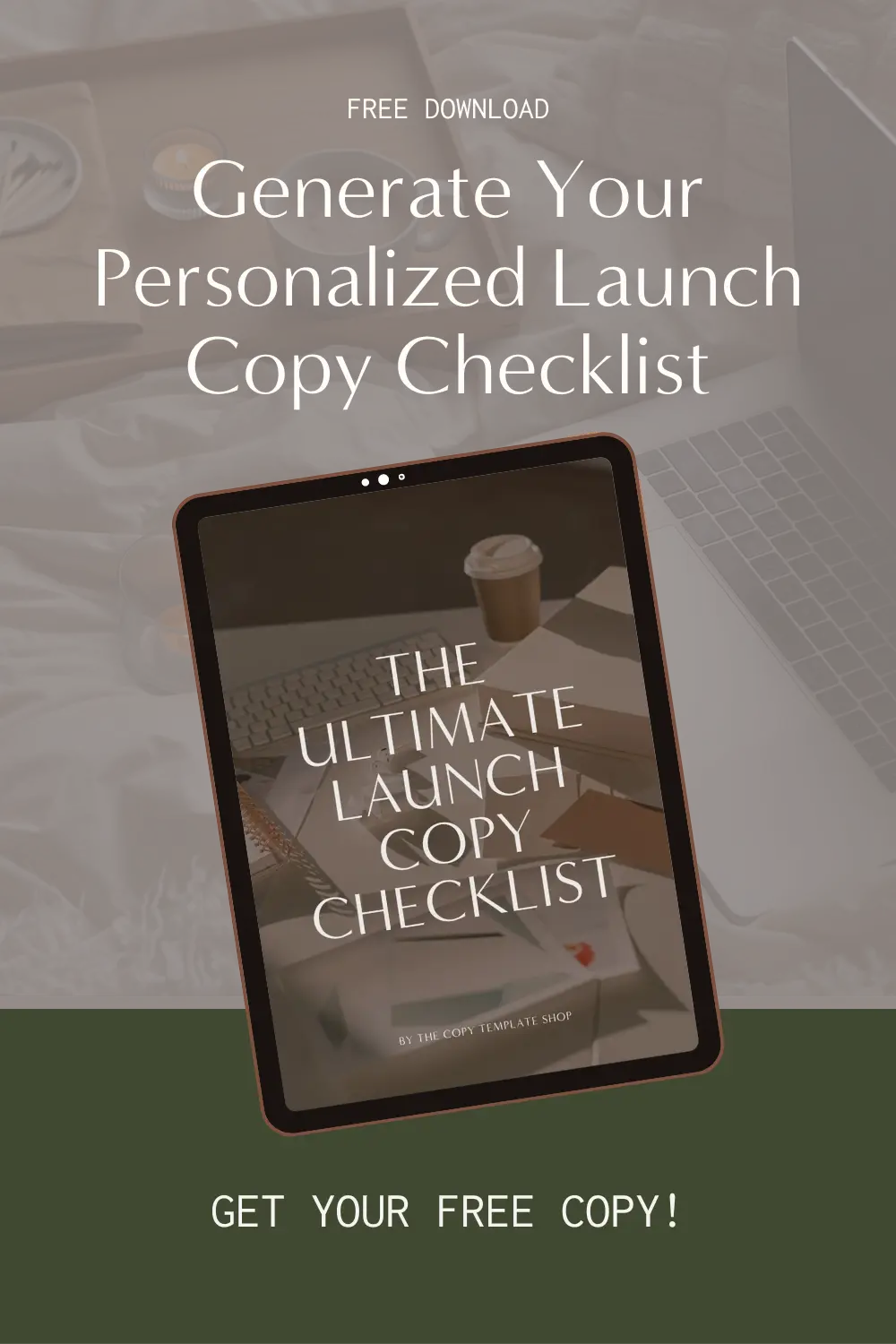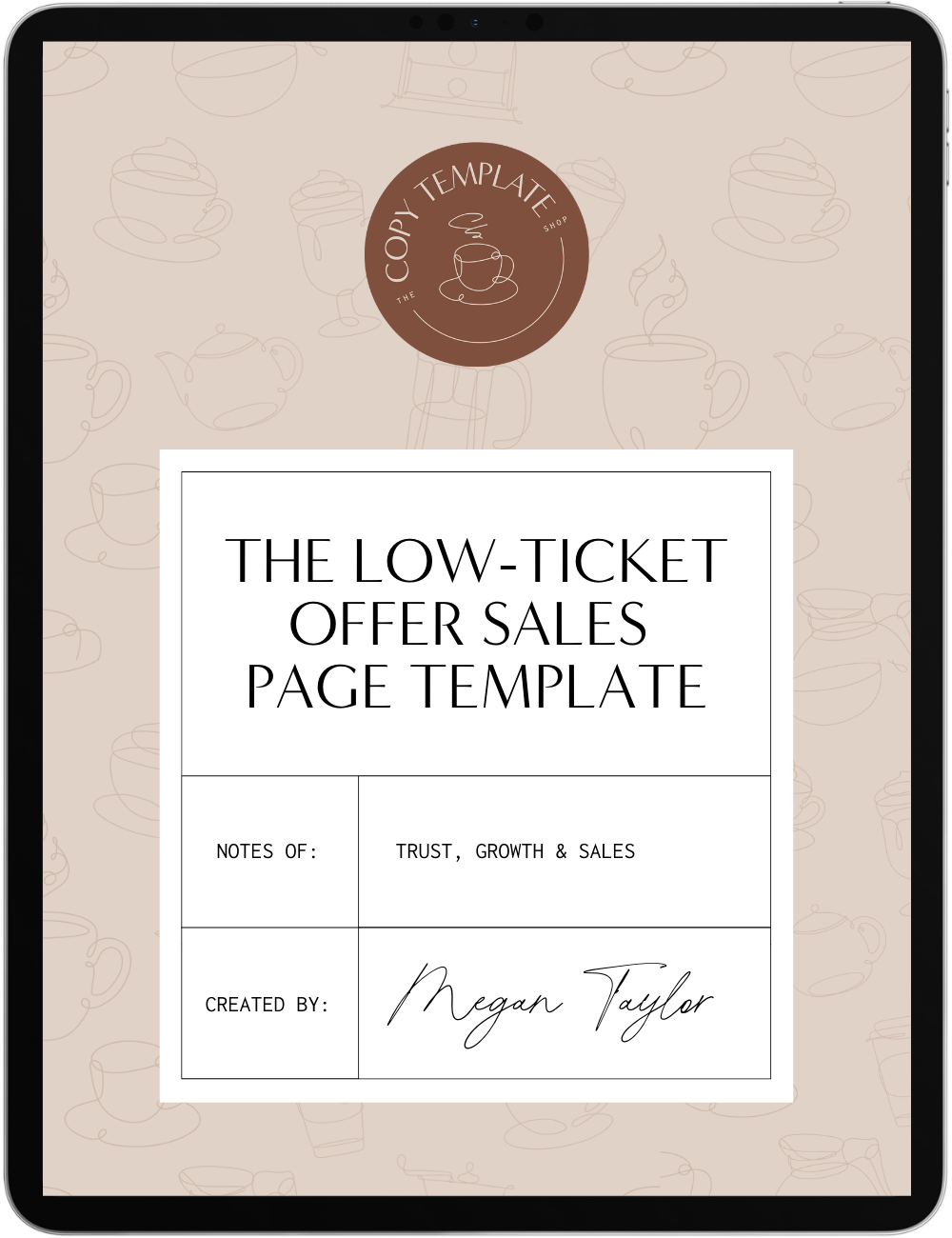Does writing launch copy sometimes feel overwhelming? There’s a bit of an art and science to the process. Like trying to brew the perfect cup of coffee, you need the right blend of flavor, strength, and warmth.
In this guide, we’re going to show you how to mix all of those ingredients together effortlessly, so you can write launch copy that’s irresistible, engaging, and exactly to your audience’s taste.
What is launch copy?
Put simply, launch copy involves all of the written material you need to share your new offer with the world — whether it’s a course, service, membership, or other type of offering.
Launch copy is so much more than just words, though. It’s a curated message that introduces your latest offer to the world, pulling together all its elements into a message that’s too tempting to pass up.
For your launch copy to be effective, you need to describe the unique aspects of your offer and weave a narrative that connects with your intended audience. When done right, launch copy doesn’t just inform; it entices, engages, and converts.
Essential Ingredients for Effective Launch Copy
If you want your launch copy to really hit the spot, you’re going to need a few key ingredients. Namely, you’re going to want to make sure that your copy is clear, concise, persuasive, and relevant. Let’s look at each of these components one by one.
1. Clarity
I want you to treat your launch copy more like an espresso shot, and less like a half-caff, sugar-free, cinnamon soy skinny latte. That is to say: get to the point, without all the frills and fixings.
Your reader should be able to quickly understand what you’re launching, who it’s for, and what purpose the offer serves. Avoid jargon, convoluted sentences, and copy that reads like a scavenger hunt. Instead, opt for copy that’s easy to digest.
Do we want to be creative and clever in our copy? Sure! But never at the expense of clarity.
2. Conciseness
Don’t get me wrong: I absolutely love a long-form sales page, and I believe in giving your reader all the information they need to make an informed buying decision. That said, it’s important to make sure you’re distilling your message into its most potent form.
Launch copy is an art of saying more with less. Try to leave your audience with memorable, succinct messages that they can carry with them throughout your launch. What do you absolutely need them to know, and what’s the most concise way of spelling that out for them?
3. Persuasion
If it makes you feel uncomfortable to think about persuasion in your sales messaging, I want to encourage you to see it as a way to genuinely connect and engage with your potential buyer (rather than an icky hard sell.)
Persuasion is really about sharing your enthusiasm for your offer and how it can make a difference in your buyers’ lives. Kind of like inviting them for a coffee chat, this is your chance to make your reader feel seen, heard, and understood.
What stories and other personal insights can you share in your launch copy to show that you really understand your audience and their needs and that you’ve created something that will help them?
4. Audience Relevance
No matter what type of offer you’re launching, you need to treat it like a custom order. You (hopefully) crafted your course, membership, low-ticket offer, done-for-you service, or other offer to serve a very specific audience; and that needs to be reflected in your launch copy.
As we’ll see in the next section, it’s incredibly important to get clear on your audience’s unique preferences, pain points, and desires… and this should all be woven directly into your launch copy.
Step-by-Step Guide to Writing Launch Copy
By now you know that your launch copy needs to be clear, concise, persuasive, and relevant. Great. But if you’re currently staring down a blank Google doc, you’re probably wondering… how the heck do I start?
Like all copywriting, writing your launch copy starts way before you even write a single word. Let’s go through the most important steps to writing launch copy that’s both compelling and that drives sales.
1. Understand Your Audience
Forgive us, we’re going to use another coffee analogy.
My go-to Starbucks order is an almond milk caramel macchiato. Does everyone love an almond milk caramel macchiato? Absolutely not. For some, it’s far too sweet. For others, 100% dairy is the only thing they’re putting in their cup.
Everyone has different wants, needs, preferences, and tastes — and that doesn’t just apply to coffee. If you want to write copy that speaks to and convinces your ideal buyer, you need to have a very clear sense of who they are and what’s going to tickle their taste buds.
Your ideal client avatar has to be defined by way more than just demographics. Ask yourself:
- Who are they? What are they interested in? What are their daily habits?
- What problem is driving their search for your offer? What’s bugging them out in their day-to-day life, and how has that brought them to your world?
- What do they want? What outcome or transformation do they desire? What does life look like when that problem is no longer a problem?
Once we understand who your intended audience is on a deep, psychological level, we can start to speak their language and offer solutions that match their unique tastes and preferences.
2. Know your key messaging
Once you know your target audience inside and out, you’re going to want to distill all of that information into a potent messaging strategy. How can you distill the essence of your offer — including the problem it solves and the transformation it delivers — into a powerful message that draws your audience in?
In the most concise way possible, try to define:
- The specific problem your offer solves, and what pain points it helps to alleviate
- The benefits of using your offer, with a focus on the benefits rather than the features
- The emotional payoff, with an emphasis on how your buyer will feel after having their problem solved
- Who your offer is right for, and who is better off finding another solution
- What makes your offer different, and why it’s the ultimate solution for your ideal buyer
- Your offer’s unique selling proposition (USP)
3. Determine your USP
Your offer’s USP is so important that it deserves its own section in this step-by-step guide.
Determining your offer’s USP requires a deep dive into what makes your offer not only different but better. Why is this course, service, membership, or other product you’re launching the best possible solution for your ideal buyer?
To get to the core of your USP, you need to consider all of the alternative solutions your ideal client might be considering — or even what solutions they’ve tried before — and pinpoint exactly why yours is the better fit.
Do you have…
- An innovative approach, framework, or system?
- Unparalleled customer service or support?
- Features they won’t find anywhere else?
- A certain level of experience or expertise in this area?
- A unique story for why you created this offer?
- Case studies, testimonials, or other evidence that your way works?
In short, try to come up with a statement that explains why, among all the options out there, your solution is the perfect fit for their needs.
4. Use Storytelling in Launch Copy
At this point, you’ve got your key messaging ready to go, including your USP. The key now is to find ways to rinse and repeat that messaging throughout all of your launch copy, and one of the most impactful and memorable ways to do this is through storytelling.
We all love a good story. Stories help us feel connected and relate to one another despite our differences. They can also help us better understand complicated ideas and start to imagine the real-life applications and benefits of different solutions.
Look back at your key messaging and ask yourself: what stories can you tell to help your audience understand how your offer is going to solve their problems and make their life better? Consider things like:
- Customer or client success stories
- Your own journey to success
- Why you created this product
- Why each feature is important
- The impact you hope to have with this offer
- Mistakes you made, and how this offer helps them avoid that fate
5. Gather Social Proof and Testimonials
Social proof — testimonials, case studies, reviews, and endorsements — helps build trust in the offer that you’re launching because it shows the reader that other people have benefitted from your solution. By showcasing other peoples’ experiences, you’re giving your credibility a nice, third-party boost.
In the most basic terms, social proof helps your reader trust that you’re not just blowing smoke and trying to sell a solution that doesn’t actually work.
If you’re relaunching an existing offer, connect with people who have bought it before and share their stories throughout your launch copy. For example, you could:
- Include testimonials throughout your sales page copy
- Dedicate an entire launch email to testimonials
- Share a specific client story in a single email
- Add client or media logos to your sales page
Launching something for the first time? What other success stories can you share to show that you know your stuff? For example, if you’re launching a course on brand design, you could share testimonials and portfolio pieces from your own brand design clients. (Just be sure to clarify which offer the testimonials refer to, so you can maintain transparency and credibility.)
6. Get clear on what copy you’ll need
By following all of the above steps before you start writing your launch copy, you’ve just made the actual writing process 100x easier. You now know exactly what messages you need to rinse and repeat throughout your launch copy to connect with your ideal buyer and convince them of the value of your offer.
The next step is to identify all of the moving pieces of your upcoming launch and determine what copy you’re going to need for each stage. I recommend writing a list of all the copy elements you’ll need before you start writing to ensure you don’t miss anything.
Need some help figuring out what launch copy you’ll need? Grab our free launch copy checklist to get a personalized copy to-do list, based on your specific offer and launch strategy.
Let’s recap how to write launch copy that converts
Writing effective launch copy is a little bit like brewing the perfect cup of joe. You need to blend clarity, conciseness, persuasion, and relevance so you can serve something that matches your audience’s tastes; and it’s important to get all the ingredients sorted before you start to write.
If you can develop a deep understanding of your audience, distill that knowledge into potent messaging, highlight your USP, and amplify your message through powerful storytelling and trust-boosting social proof, you’ll have all the tools you need to craft launch copy that not only engages but actually helps you reach your sales goals.




